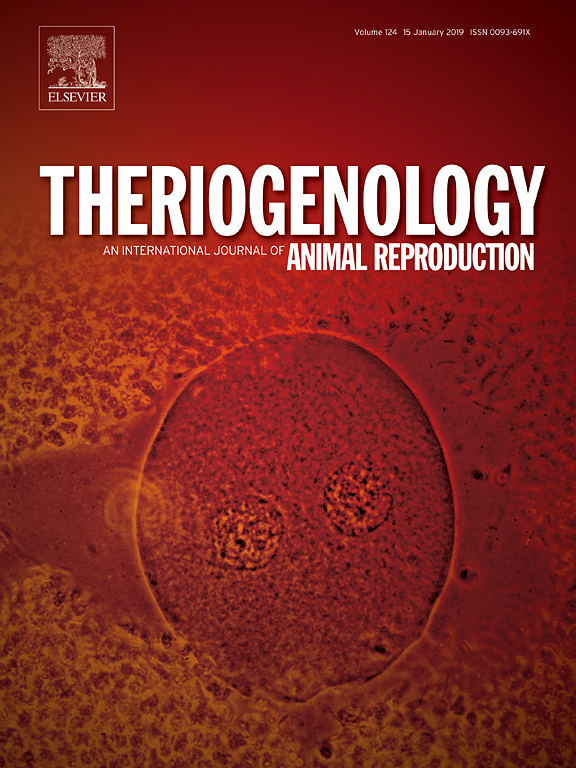Ver ítem
- xmlui.general.dspace_homeCentros Regionales y EEAsCentro Regional Patagonia NorteEEA BarilocheArtículos científicosxmlui.ArtifactBrowser.ItemViewer.trail
- Inicio
- Centros Regionales y EEAs
- Centro Regional Patagonia Norte
- EEA Bariloche
- Artículos científicos
- Ver ítem
Effect of GnRH or hCG administration on Day 4 post insemination on reproductive performance in Merino sheep of North Patagonia
Resumen
Different therapeutic strategies have been used with the objective of improve luteal function to reduce embryonic losses. The objective of this work was to study the effect of the administration of GnRH or hCG at Day 4 post fixed time artificial insemination (FTAI) on reproductive efficiency in Merino sheep during the breeding season in North Patagonia. Estrus of multiparous Merino ewes (n ¼ 288) was synchronized by two injections of prostaglandins (PG;
[ver mas...]
Different therapeutic strategies have been used with the objective of improve luteal function to reduce embryonic losses. The objective of this work was to study the effect of the administration of GnRH or hCG at Day 4 post fixed time artificial insemination (FTAI) on reproductive efficiency in Merino sheep during the breeding season in North Patagonia. Estrus of multiparous Merino ewes (n ¼ 288) was synchronized by two injections of prostaglandins (PG; 125 mg, Cloprostenol), 14 days apart. Cervical FTAI was performed
53e56 h after the second PG with a dose of fresh semen (100 X 106 spermatozoa) from five Merino rams. In all ewes body condition score (BCS) was determined at FTAI. At 4 days post FTAI ewes were randomly assigned into three experimental groups: GnRH group (4 mg, Buserelin; n ¼ 99), hCG group (300 IU, hCG; n ¼ 92) and Control group (1 ml, saline solution; n ¼ 97). Pregnancy and pregnancy
losses were evaluated by ultrasonography on Days 33 and 90 post FTAI. Additionally, embryo crownrump length (CRL) was measured by ultrasonography (n ¼ 12 single-pregnant ewes by experimental group) at the first ultrasound. Date of birth, litter size and lamb weight were recorded (n ¼ 111 pregnant ewes). Pregnancy rate on Days 33 and 90 post FTAI did not differ among treatment groups (P > 0.05). Pregnancy losses at Day 33 post FTAI were lower in the hCG group compared to the GnRH and Control groups (0, 3, 7.2%, respectively; P < 0.05). Pregnancy losses between Days 33 and 90 after FTAI were negligible (P > 0.05). The embryo CRL at Day 33 post FTAI was not increased by the hormonal treatments (P > 0.05). Moreover, it was lower in GnRH group compared to Control group (P < 0.05). Litter size tended to be greater in the GnRH group compared to the hCG and Control groups (P < 0.1). The birth weight of
twin lambs tended to be higher in the GnRH group compared to the Control group (P < 0.1). The birth weight of single lambs was not affected by treatments (P > 0.05). Ram fertility and BCS of ewes at FTAI influenced the effect of hormonal treatments on reproductive parameters. In conclusion, administration of hCG or GnRH at Day 4 post FTAI does not improve pregnancy rate but treatment with hCG reduces pregnancy loss on Day 33 post FTAI. GnRH treatment improves litter size and twin lambs birth weight.
[Cerrar]

Autor
Fernandez, Jimena;
Bruno Galarraga, Maria Macarena;
Soto, Andrés Telésforo;
De la Sota, Rodolfo Luzbel;
Cueto, Marcela Isabel;
Lacau Mengido, Isabel María;
Gibbons, Alejandro Eduardo;
Fuente
Theriogenology 126 : 63-67 (March 2019)
Fecha
2018-12
Editorial
Elsevier
ISSN
0093-691X
1879-3231
1879-3231
Formato
pdf
Tipo de documento
artículo
Palabras Claves
Derechos de acceso
Restringido
 Excepto donde se diga explicitamente, este item se publica bajo la siguiente descripción: Creative Commons Attribution-NonCommercial-ShareAlike 2.5 Unported (CC BY-NC-SA 2.5)
Excepto donde se diga explicitamente, este item se publica bajo la siguiente descripción: Creative Commons Attribution-NonCommercial-ShareAlike 2.5 Unported (CC BY-NC-SA 2.5)

